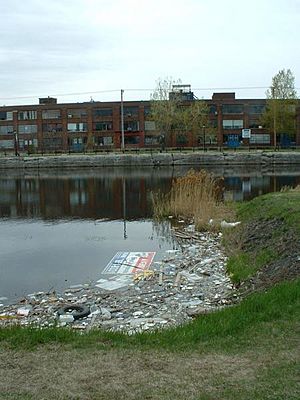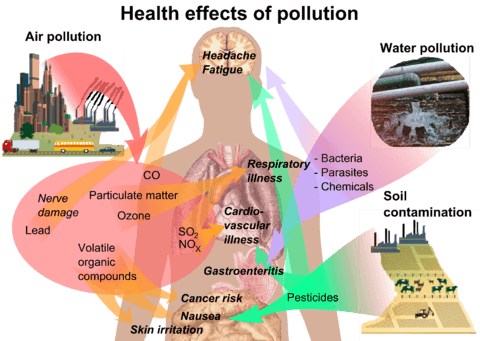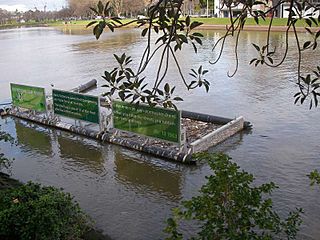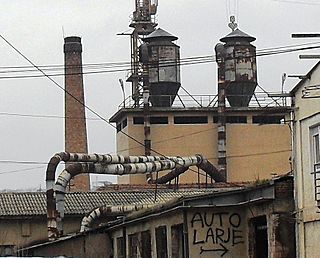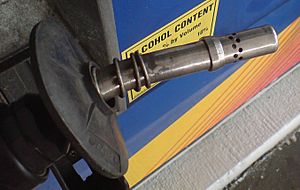Pollution facts for kids
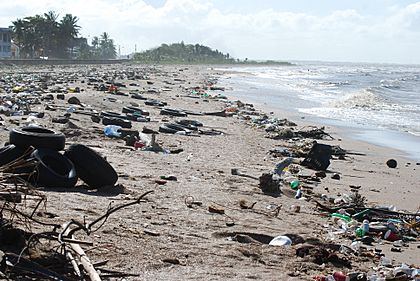
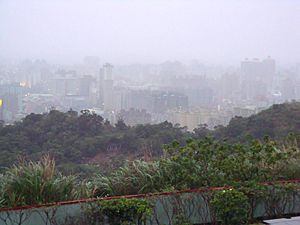
Pollution happens when harmful or poisonous things are added to our environment. These things can hurt living creatures and the natural world. There are four main kinds of pollution: air, water, noise, and land (or soil) pollution.
For example, smoke or dust in the air is a type of pollution. It can be bad for our lungs when we breathe it in. Sewage in drinking water is also pollution. It can make people sick because it carries germs and viruses.
Too much noise, like from a busy building site, can also be harmful. It can stop people from sleeping well and make them feel unwell. Dangerous chemicals can also get into the soil from trash and other man-made products.
As pollution has grown, so have the ways we try to stop it. Using solar and wind energy are good examples. These clean energy sources help power homes without adding harmful gases like carbon dioxide to the air.
Contents
What is Pollution?
Pollution is when harmful things, called pollutants, enter our natural world. These pollutants can be chemicals, loud sounds, heat, or even bright lights. They can come from natural sources, like volcanoes, but most often they come from human activities. When pollutants are released, they can cause bad effects on living things, different ecosystems, and the environment as a whole.
Understanding Air Pollution
Air pollution is caused by harmful gases and tiny particles in the air. These include poisonous gases like sulfur dioxide, nitrogen dioxide, and carbon monoxide. Smoke and harmful gases from vehicles and factories also cause air pollution. Burning coal, wood, and kerosene for fuel also adds to it.
Air pollution can lead to breathing problems like asthma. It can also cause other serious health issues, including cancer. Air pollution also contributes to global warming and acid rain. This can make temperatures rise, cause strange rain patterns, and lead to droughts around the world. These changes make it harder for living things to survive.
Exploring Water Pollution
Water pollution means that harmful materials are present in water. These can be things like sewage, dissolved metals, waste from farms or factories, and crude oil spills. The main things that pollute water are nitrates from fertilizers, sewage, and detergents.
When people wash clothes or bathe near lakes and rivers, they add nutrients like nitrogen and phosphorus to the water. This can cause too much algae to grow on the water's surface. This thick layer of algae blocks sunlight and air from reaching the water below.
Water pollution harms creatures living in the water. It can also be very bad for people's health. In serious cases, it can even cause diseases like cancer.
The Impact of Noise Pollution
Noise pollution, also known as sound pollution, is any loud sound that is harmful to humans and animals. This includes the noise from vehicles, loud music, and construction. Too much noise can cause ear problems or even lead to permanent deafness, especially in older people.
Soil and Land Pollution
Soil pollution, also called land pollution, happens when man-made chemicals get into the soil. These chemicals can be hydrocarbons, heavy metals, or solvents. They often come from industrial activities and poor waste management.
Soil pollution can create health risks. The chemicals might release harmful vapors into the air. They can also contaminate the water supplies that are found underground.
Plastic Pollution
Plastic pollution is when plastic products build up in the environment. This negatively affects wildlife, their homes, and even humans.
Effects of Pollution
On Human Health
Poor air quality can harm many living things, including people. Pollution from ozone can cause breathing problems, heart issues, and chest pain. In 2010, it was estimated that 1.2 million people died too early in China because of air pollution. High levels of smog in China have caused many health problems for people.
The WHO estimated in 2007 that air pollution causes half a million deaths each year in India. Studies suggest that over 50,000 people might die each year in the United States due to air pollution.
Water pollution causes about 14,000 deaths every day, mostly in developing countries. In these places, water is often contaminated by untreated sewage. In India, about 500 million people do not have access to a proper toilet. In 2013, over ten million people in India got sick from waterborne illnesses, and 1,535 people died, many of them children. Nearly 500 million Chinese people also do not have safe drinking water.
Oil spills can cause skin irritations and rashes. Noise pollution can lead to hearing loss, high blood pressure, stress, and trouble sleeping.
Eating mercury has been linked to problems with how children develop and can cause nerve issues. Older people are more likely to get sick from diseases caused by air pollution. People with heart or lung problems are at even higher risk. Babies and young children are also very vulnerable.
Lead and other heavy metals can cause problems with the brain and nerves. Chemical and radioactive substances can cause cancer and birth defects. A study in 2017 found that pollution worldwide, especially toxic air, water, soil, and workplaces, kills nine million people every year.
On the Environment
Pollution is widespread in the environment and has several effects:
- Biomagnification is when toxins, like heavy metals, become more concentrated as they move up the food web.
- Carbon dioxide emissions cause ocean acidification. This means the Earth's oceans are becoming more acidic as CO
2 dissolves into them. - The release of greenhouse gases leads to global warming. This can affect ecosystems in many different ways.
- Invasive species can take over from native species, which reduces the variety of life, known as biodiversity.
- Nitrogen oxides are washed out of the air by rain and act as fertilizer for land. This can change which types of plants and animals live in an ecosystem.
- Smog and haze can reduce the amount of sunlight plants receive for photosynthesis.
- Soil can become infertile, meaning it's not good for growing plants. This then affects other organisms in the food web.
- Sulfur dioxide and nitrogen oxides can cause acid rain. This lowers the pH level of soil and water.
- Organic pollution in water can reduce oxygen levels and decrease the variety of species living there.
Controlling Pollution
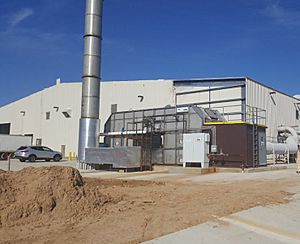
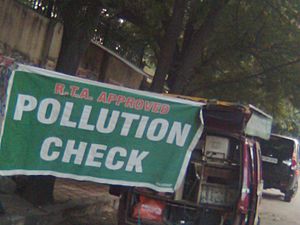
Pollution control is about managing what goes into our air, water, or soil. Without pollution control, the waste from things like over-shopping, heating homes, farming, mining, and transportation could seriously harm our environment. Many people believe that preventing pollution and creating less waste is even better than just controlling it after it happens.
Helpful Practices
- Recycling materials instead of throwing them away.
- Reusing items whenever possible.
- Reducing the amount of waste we create.
- Fixing environmental damage.
- Stopping pollution before it starts.
- Composting organic waste.
Devices to Control Pollution
- Air pollution control systems, like:
- Thermal oxidizers
- Dust collection systems, such as:
- Baghouses
- Cyclones
- Electrostatic precipitators
- Scrubbers, which clean gases, including:
- Baffle spray scrubbers
- Cyclonic spray scrubbers
- Ejector venturi scrubbers
- Mechanically aided scrubbers
- Spray towers
- Wet scrubbers
- Sewage treatment systems:
- Sedimentation (first step)
- Activated sludge biotreaters (for industrial wastewater too)
- Aerated lagoons
- Constructed wetlands (also for city runoff)
- Industrial wastewater treatment systems:
- API oil-water separators
- Biofilters
- Dissolved air flotation (DAF)
- Powdered activated carbon treatment
- Ultrafiltration
- Vapor recovery systems
- Phytoremediation, using plants to clean up pollution.
Interesting Facts About Pollution
- Cleaning up polluted areas can save animals' lives. It also helps discourage people from littering again.
- People who live in places with a lot of air pollution have a 20% higher chance of dying from lung cancer.
- Certain plants can actually filter air pollution.
- There are over 73 types of pesticides found in groundwater used for drinking.
- About 40% of lakes in America are too polluted for fishing, swimming, or for aquatic life to thrive.
- In 1975, it was estimated that cargo ships and cruise liners had dumped 14 billion pounds of garbage into the ocean.
- Homeowners sometimes use chemicals that are 10 times more toxic per acre than what farmers use.
- In the U.S., 41% of all insecticides are used on corn. Most of these treat a pest that could be controlled just by growing a different crop for one year.
- Americans buy more than 29 million bottles of water every year. Only about 13% of these bottles are recycled.
- Recycling and composting have become much more popular. In 2010, these efforts kept 85 million tons of material out of landfills, a big jump from 18 million tons in 1980.
- Noise pollution is often the most overlooked type of pollution.
Images for kids
-
A map showing the Great Pacific garbage patch.
See also
 In Spanish: Contaminación para niños
In Spanish: Contaminación para niños



